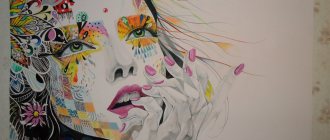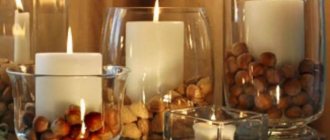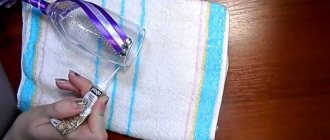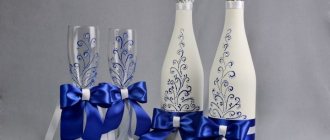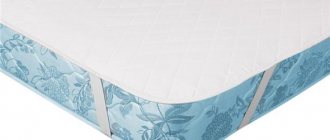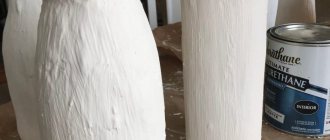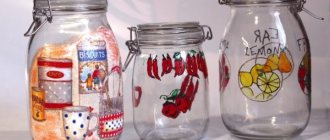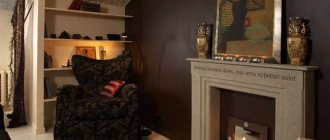/Accessories and decor/Decoration/
Glass or ceramic vases, painted and decorated by yourself, can be an excellent gift, wedding decoration or decorative item for your home. Hand painting on glass/ceramics, depending on the desired design and technique, can be either complex, requiring skills, or very simple, accessible to beginners.
Decorative glass painting
Why should painting glass surfaces be done in the kitchen? The motifs that a novice artist depicts will lack rigor. They are great for decorating a small kitchen.
If the artist displays every detail in the painting, a mosaic effect will appear. The image will visually consist of several color strokes. Painted paintings look especially gentle and elegant on glass objects.
Painting is carried out using silicate paints.
Paints are sold in specialized departments; they can be matte or transparent. Glass artists also use acrylic and stained glass paints. First you need to decide what exactly will be applied to the glass apron, cabinet doors or set of dishes. If your imagination and abilities allow, draw a sketch yourself, be it pictures of fruits, flowers or a landscape. If you have problems with your drawing technique, you can always download your favorite drawing, stencil or template and apply it.
Thickened paints can always be “revived” with a solvent.
Technique
- Outline and fill specific areas.
- Tiffany. Creates a three-dimensional image effect. Helps create a realistic image, the effect of being close or far away. This type of technique also covers small elements; the border of the picture is fragile.
- Artistic stained glass for cabinets or table glass.
First, the surface of the glass panels that is planned to be painted is prepared: wiped with a dry cloth, degreased with soapy water or alcohol, and wiped dry. Next, you can begin to draw the outline of the picture. It is applied with a pencil or felt-tip pen. After the outline has completely dried, you can begin painting. Each shade is taken with a separate brush. The paint should not extend beyond the boundaries of the applied contour. Once the paint is applied, you just have to wait for it to dry.
The result is fixed with a transparent varnish, giving the design a glossy shine. Aerosol varnish will help create an antique effect.
Double stroke technique
Half the brush should be dipped in one color, and the other half in the second. Using one brush, two colors are applied simultaneously. The optimal combination is brown and white. If you brush across the surface of the vase, the brushstroke will be two-color. In this case, the transition of colors will be smooth. You need to put paint on a brush and apply the design to the paper first. In this case, the brush will lie horizontally in relation to the image. Next you need to draw a straight line. When the lines are drawn, you will get an unusual weaving pattern. The lines must be drawn alternately - vertical, then horizontal. All lines are drawn in a checkerboard pattern. When you make test strokes, you will be able to understand what thickness of paint will be optimal. You will also understand how well the paint will adhere and whether you will like the drawing in the end. If everything is good, then you can go to work.
Painting dishes
Hand-painted dishes are a pearl in the kitchen, a source of special pride. Once you try painting on dishes, you can acquire a favorite hobby for the rest of your life. Two types of paints are used for painting: stained glass and acrylic. Both types are used on glass and ceramics; then you can use the finished dishes as usual.
Some tips for beginners:
- It is better to start creativity using transparent glassware or snow-white ceramics. Then nothing will distract attention from the drawing.
- First you need to “draw your hand” on a sheet of paper. Practice the hardness of your strokes, drawing out thin and thick lines, and a smooth transition from thick to thin lines. It's great if you learn the spindle stroke - this is the main way to paint flowers.
- The next step is to learn how to draw flowers. The main thing is to combine shades, to prevent one stroke from merging with others. Try making a transition from a dark shade to a light one.
- To add transparency to your drawing, wet your brush with water.
- Create a sketch of the future design, cut it out and apply it to the dishes. Professional tableware painters are so confident in their skills that they don’t use sketches, they paint straight away.
- The dishes are first washed and degreased. The contour dries completely in a couple of hours.
- Paint the picture with paints; it is better to use a horizontal plane for drying.
An acrylic picture will dry in a day, a stained glass picture will be dry in six hours. Dishes painted with stained glass paints must be fired in the oven for 40 minutes.
Painting on glass with acrylic master class. How to create an interesting decor for the kitchen from an ordinary jar:
The acrylic drawing also becomes stronger after 15 minutes of firing. Heat treatment is carried out in the oven at a temperature of 150 degrees. The dishes cool down on their own.
Painting plates
Gzhel
Gzhel is the name given to Russian folk art; it is recognizable in all countries of the world. This type of hand painting consists of simple lines, drops, nets, and blue flowers on a white canvas.
If you like the combination of snow-white and blue, then you can create a whole panel of plates with Gzhel painting in blue tones.
Work process:
- A ready-made pattern or drawing is taken. The round shape of the plate encourages you to create a sketch that fits organically into the circle.
- A sketch is made on the plate with a marker.
- The main drawing is drawn using a brush with a thin tip.
- White paint paints accents on the blue drawing and makes transitions.
- Before you start painting the next element, you need to wait until the previous one dries.
In order for the drawing to look like classic Gzhel, the lines must be smooth and wavy, but at the same time clear.
Master class on painting in Gzhel style. Paint a plate beautifully - it's easy:
Khokhloma
Painting plates under Khokhloma is an interesting and exciting activity. This type of Russian art originated in the 17th century in Nizhny Novgorod.
Khokhloma is the painting of wooden utensils in red, black and green on a yellow background.
Work process:
- An ornament is taken from a book or the Internet and transferred to a plate.
- The background is drawn, going around the leaves and berries.
- The remaining elements are filled with the desired color.
- The necessary touches are added: droplets, curls.
- The plate is drying.
Other types of Russian painting on plates:
- Petrikovskaya painting. Bright flowers, birds, and patterns are drawn on a black or gold background.
- Gorodets painting. The subject for such a painting will be a Russian hut, its inhabitants and the attributes of the life of the people. It is done with free strokes with a white or black outline.
Folk painting includes the simplest patterns, flowers, berries, natural phenomena in everything that surrounds us in nature.
Contemporary paintings on glass and ceramics
- Inscriptions. On the eve of the holiday, you can display congratulations or the name of the hero of the occasion on the dishes. The inscriptions in the form of lines from a letter look beautiful. There are many options here.
- The simplest patterns: polka dots, stripes, squares, any geometric shapes look very original.
- Vanguard. There are simply no boundaries in the options here: blots, random lines, lack of symmetry.
- Ombre technique. The ombre effect is achieved by applying paint with a sponge. An ombre effect also appears if liquid streaks of paint are dispersed with a needle.
The combination of a child, a plate and paint gives an extraordinary result. Any child’s drawing will decorate the kitchen and will delight parents and guests.
Let's talk about some nuances
To paint a vase with acrylic paints, you need to be patient and allocate a certain amount of time for this work. It’s easy to fantasize and bring your ideas to life if you know exactly what you ultimately want to get. Painting is a rather labor-intensive process. It is important to do everything carefully and not to rush. If the vase is floor-standing, then painting will require even more effort and time. But if you use masking tape as a handy stencil, you can decorate it quickly enough. It is necessary to approach the choice of paints that match the color very carefully. Unusual shades: silver, gold, pastel, copper, black and white will turn a completely unremarkable glass vase into a luxurious piece of designer decor.
Glass painting
Glass painting today is a separate and very common type of creativity. Hand-painted glasses look rich and beautiful.
Materials required for painting glasses:
- Stationery.
- Special circuit.
- Brushes.
- Special paints for glass (there are acrylic coating paints, as well as transparent stained glass paints).
- Cotton pads and cotton swabs, toothpick.
- Degreaser.
Acrylic matte paints are not afraid of water. Stained glass windows are divided into fired and unfired. You should avoid water-based paints and use alcohol based paints.
Operating procedure:
- Degrease glasses with acetone or detergent.
- Place the sketch cut out of paper inside the glass and secure with tape.
- Draw an outline on the surface of the glass with a solid line.
- Allow the outline to dry. You will have to wait from half an hour to three hours.
- Fill the outline with paints. If necessary, place the glass horizontally.
- Remove excess paint with a cotton swab and remove air with a toothpick.
- The glass must be dry. It will take from several hours to a day.
- When using non-fired paints, the fixing is done with a colorless acrylic coating. For those who need to be burned – roast in the oven for 10 minutes. Place the glass in a cold oven and remove it after it has cooled completely. Make sure the glass can withstand high temperatures.
Themes for different occasions
- Hand-painted glasses are a wonderful gift for newlyweds. Doves, rings or two hearts are painted on them. All these symbols will fit perfectly into wedding paraphernalia.
- You can surprise your guests on New Year's Eve too - glasses with painted Christmas tree decorations, fir trees and snowdrifts will lift everyone's spirits. A great idea is to draw Father Frost on one glass and the Snow Maiden on the other.
- In a similar way, you can decorate glasses for Halloween (pumpkins), Valentine's Day (hearts).
Watch the master class for painting glasses:
How to decorate a vase yourself
The desire to feel like a decorator can really be realized if you pick up a vase. Depending on its material - glass, porcelain, clay, the level of skill and performance will be different.
Beautiful vases decor is achieved with due diligence and developed imagination. A born designer will show her talent, and a skilled needlewoman will show her skills in working with materials.
Door decor
Painting glass doors is now gaining popularity. This solution is used for wardrobes, interior doors, and kitchen units. Stained glass painting produces extremely beautiful results.
How to create stained glass windows
- Remove the door from its hinges.
- Prepare a sketch of the future drawing.
- Draw a sketch on the glass door of the kitchen unit with a pencil and then with a black felt-tip pen.
- Take out the glass and degrease it.
- Apply the contour with a special pencil-contour on the glass.
- Do not break the outline, otherwise the paint will spread.
- Give the outline time to dry.
- Paint over the drawing.
- Let the glass dry. This takes days.
How to make stained glass on glass, see here:
Plastic vases – universal potential
Absolutely any materials are suitable for decorating a plastic vase - from twine and cords to culinary trifles (seeds, poppy seeds, cereals).
Satin ribbons, napkins for decoupage, dry plants, pieces of artificial leather - everything will find a place with the right level of imagination.
When decorating a vase, any handicraft technique is suitable:
- Quilling: folded circles of corrugated paper are conveniently glued to the surface of the vase;
- Patchwork: if the vase has an ugly shape or cracks that need to be hidden, you can sew an attractive cover from scraps and “put” it on the body;
- Beading: a container braided with chains of beads strung on a fishing line will shimmer in the light and produce the desired effect;
- Crochet: finely knitted lace looks original on a transparent background.
You can make original decor for vases at home yourself or with your children.
Painting ceramic tiles
Ceramic tiles are a great canvas on which to hone your craft. The tiles should be smooth, without patterns, and monochromatic. You can also use multi-colored tiles on the apron.
Operating procedure:
- Degrease the tiles with detergent and a sponge.
- Sand with sandpaper.
- Apply epoxy primer and let it dry.
- The paint is applied to the tiles in several layers. Subsequent layers are applied only after the previous ones have dried.
- Adjust the drawing with cotton pads.
- Apply waterproof varnish.
Patchwork tiles have many advantages: an abundance of color schemes, a huge number of themes, and the exclusivity of each hand-painted piece of furniture . It is worth noting that many interior styles welcome painting and decoupage of tiles. These are country, Provence, English or Moroccan styles, vintage or decoupage furniture in the shabby chic style.
Glass painting in the kitchen, equipped with lighting, looks especially elegant.
Disadvantages include the complexity and labor-intensive nature of the process. But the pleasure of contemplating a unique piece of furniture created with your own hands is worth all the effort.
Caring for painted glass objects
Decorative glass objects painted with paints cannot be used in everyday life without following certain rules. Of course, you can coat the products with varnish, which will make them more durable and protect them from scratches (many paints are sold complete with a suitable varnish), but even in this case, adhere to the following care rules:
- Do not place painted glassware in the dishwasher or use detergent.
- Do not soak for a long time, do not wipe with force.
- The best way to clean a painted glass piece is to gently wipe it with a soft cloth dampened in warm water.
- To improve the water and light resistance of the product, apply a thin layer of varnish to the painted surface with a wide brush immediately after the paint has dried.
Stylish geometry
This vase will decorate any interior and become a stylish accent. To do this, you don’t need to be able to draw or have any abilities. All you need is masking tape, spray paint, a brush, degreaser and cotton swabs.
First, treat the vase with a degreaser and a cotton pad. After the surface has dried, cover the vase with tape in any order.
We spray paint the vase, using tape to make sure the edges are clear and even. All you have to do is wait until everything dries and carefully remove the tape. Agree, such a vase looks much more interesting than a transparent one.
A geometric design looks very nice if you use narrow tape.
The decor that partially covers the vase at the bottom looks no less attractive. In order not to paint over the transparent areas, we use a plastic bag and attach it with tape.
Golden sparkles are an excellent solution for decorating a transparent vase in a geometric style.
It is very important to choose the right shades to decorate the vase so that it complements the interior and goes well with it. The most universal are considered to be various pastel, gold, silver, copper shades, as well as white and black.
How to make stained glass on glass at home
Preparation for stained glass technology is standard. The image itself is first applied along the borders with a special varnish; it serves as a barrier against paint spreading. For this reason, when making a detail in the drawing, you should not interrupt the line. After finishing the work, the result is fixed with varnish.
The image itself is first applied along the borders with a special varnish; it serves as a barrier against paint spreading.
The article described how to paint glass correctly so that it acquires a more interesting structure. There are many options for suitable paints on the market; the composition should be chosen taking into account the operating conditions. The painting process is simple, you can do it yourself.
